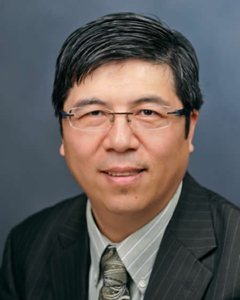Jie Han, Ph.D., P.E., F.ASCE, is the Glenn L. Parker Professor of Geotechnical Engineering at the University of Kansas and a long-time member and supporter of IGS North America (IGS-NA). IGS-NA group manager Chris Kelsey interviewed Prof. Han by email regarding his candidacy for Vice President in the 2022 International Geosynthetics Society (IGS) Elections. Prof. Han has spent the past four years serving on the IGS Council and is active in leadership with the ASCE Geo-Institute as well.
IGS North America encourages all members to actively participate in the IGS Elections, which are open for voting into mid-June. If you cannot locate your ballot invitation, please contact IGS office, igssec@geosyntheticssociety.org.
After years of actively supporting the IGS and IGS North America, you are running for IGS Vice President. What motivates you to seek this office in the current election?

Jie Han, Ph.D., P.E., F.ASCE, is the Glenn L. Parker Professor of Geotechnical Engineering at the University of Kansas
IGS is a great organization that promotes the proper use of geosynthetics in the world. I am very fortunate to have been an IGS Council Member of this great society for the past four years. I witnessed and participated in several activities and initiatives that have made positive impacts on the geosynthetics community, such as helping bring about the new, open access IGS Digital Library.
From the career side, I have had working experience in the geosynthetics industry as an engineer, in academia as an educator and researcher, and in different professional organizations as a leader.
I feel I can make more contributions to the geosynthetics community by developing coalitions to achieve the common goal that benefits the geosynthetics and geotechnical fields. I have also been a beneficiary of the geosynthetics community through my career – growing from a student, an engineer, to now a professor and researcher. I hope becoming a leader as IGS Vice President and can set an example to encourage students and young engineers/researchers to pursue and grow their career in geosynthetics.
Is it important to you to represent the perspective of education and research in IGS leadership?
Yes. Even though geosynthetics have been successfully used in many projects, they have rarely been included in undergraduate education for engineering degrees at most universities. IGS has an excellent Educate the Educators (EtE) program, which should be expanded and improved. The geosynthetics industry has been very innovative and has continuously produced new products, improved product performance, and developed new applications, which often require research for verifications, improvements, and implementations. I think IGS can play an active role in disseminating new information and knowledge globally through education, conferences, webinars, and the IGS Digital Library.
You have been an advocate for improving access to engineering information on the internet. What other opportunities exist for digital outreach by the IGS?
With rapid change of the world to an information era and due to the unforeseen pandemic, many organizations and societies have been forced into or demanded to provide access to information on the internet for their members. IGS, under the leadership of President Chungsik Yoo, took quick action to develop the IGS Digital Library and the IGS University Online Lecture Series. These digital and online resources have well served our members and the public.
Certainly, there are more opportunities for IGS to expand our digital outreach by expanding the database and adding new features and functions. For example, we can develop training courses to serve practicing engineers, geosynthetic manufacturers and suppliers, and contractors. We can also develop short videos to help policy makers and the public understand the importance and contributions of geosynthetics to general society and daily life.
How can we improve the connections between industry, sister societies, and educational institutions to support the next generation of engineers?
Even though different organizations or societies may have different missions, their common goal related to geosynthetics is to promote the use of geosynthetics for a better future. I have been involved in several organizations by playing different leadership roles. For example, I have been a Council Member for IGS since 2018, I am now a governor and the treasurer of the ASCE Geo-Institute and the past chair of the Soil Improvement technical committee, and I am the current chair of the US Transportation Research Board (TRB) Transportation Earthwork Committee.
In addition, I have served as a conference or technical chair for past and ongoing geosynthetics conferences or geosynthetic-focused conferences organized by or partnered with the geosynthetics industry.
Lastly but not the least, I am a professor at a university teaching and researching geosynthetics. I strongly believe that it is mutually beneficial for all parties to work together to support the next generation of engineers and advance the development of geosynthetic materials, technologies, and applications.
All superheroes have an origin story. How were you introduced to geosynthetics?
The first time I learned about geosynthetics was in 1985 when I took an undergraduate class of ground improvement at Tongji University in China. Geotextiles were introduced in this class as a new material and technology. In 1989, I attended the second Chinese national geosynthetics conference. In 1997, I participated in the student paper competition at the Geosynthetics conference in Long Beach, California, which was organized by IFAI and the North American Geosynthetics Society (NAGS) – now the IGS-NA. Even though I did not win the competition, that event drew me into the geosynthetics industry. One month later, I started to work as a design engineer for Tensar Earth Technologies, Inc. (now Tensar International).
THE 2022 “5 QUESTIONS” SERIES FOR THE IGS ELECTIONS